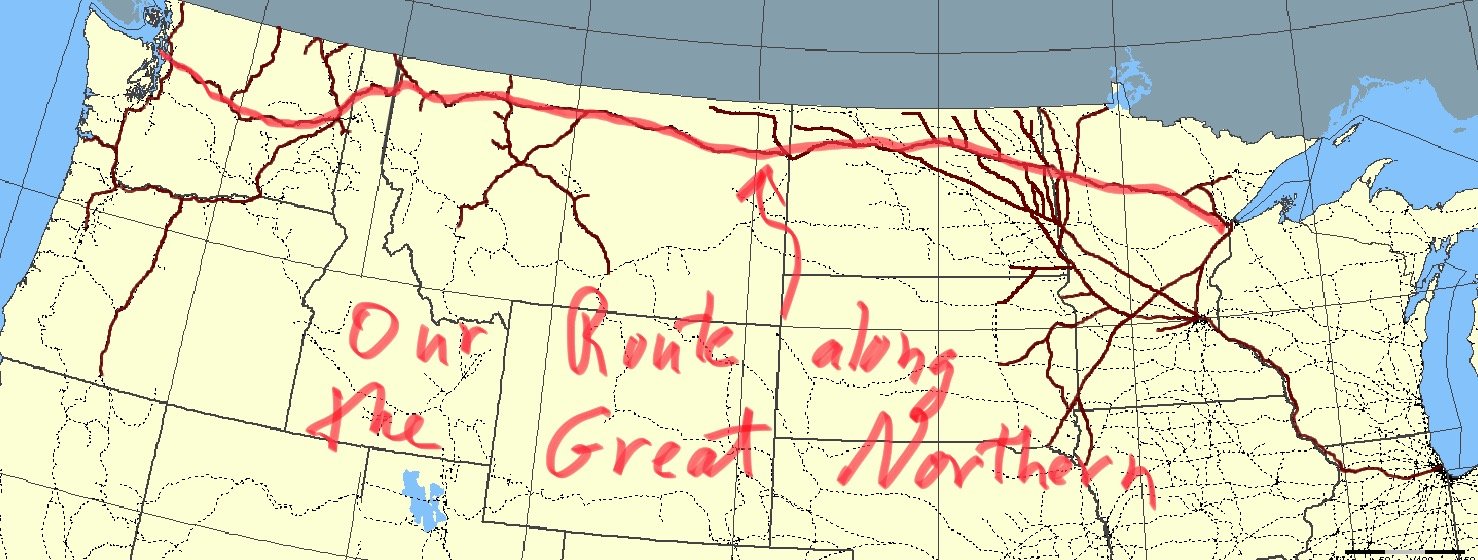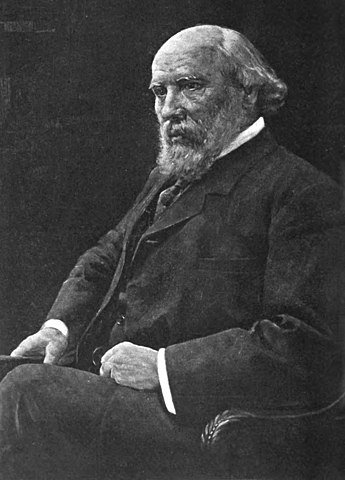Blue View - Following the Great Northern Railway
/Most of the western portion of our route along US-2 follows the tracks of the Great Northern Railway, and I thought it would be good to talk a little about the history of this particular railroad. It was the creation of James Hill, a nineteenth century entrepreneur. I love rags-to-riches stories, and his was one of the more amazing ones.
James Hill
James was born in Canada, and although he was a bright student, he was forced to drop out of school at an early age when his father died. One of his first jobs was as a clerk, where he learned bookkeeping. When he turned 18, he decided to move to the U.S., and settled in St. Paul. His first job there was as a bookkeeper for a steamboat company, then he worked as a freight scheduler for wholesale grocers. These two jobs taught him a great deal about freight companies, especially railroad and steamboat companies.
He soon moved on to businesses of his own. In 1867, he bought a coal business, and by 1879, had grown it to five times what it was when he started it. In 1870, he started a steamboat company between St. Paul and Winnipeg, and by 1879, he had a monopoly on the route. He also bought several bankrupt companies, turned them around to profitability and sold them. His stated secret to success - “work, hard work, intelligent work, and then more work”.
The panic of 1873 caused a number of railroads to go bankrupt. One of these was the St. Paul and Pacific Railroad (StP&P), in which James saw a golden opportunity. He put together a group of investors to raise the money to buy the railroad… along with many miles of rail right-of-ways which were almost as valuable as the railroad.
Hill was a hands-on, detail-oriented manager, and the newly named Great Northern Railway (GN) was soon profitable. He plowed these profits back into the company to help fund expansion. When new track was to be added, he was usually the one on horseback scouting the best route. To promote settlements along his rail lines, he sold homesteads to immigrants and transported the families and their belongings on his trains. He even employed agents in Germany and Sweden to convince people to come to America and buy his land. Under Hill’s management, the GN prospered and grew. He bought it for $728,000 in 1880; five years later it was worth $25 million - about $750 million in today’s dollars. Not bad.
By 1889, the GN had routes throughout Minnesota, into Wisconsin, across North Dakota and into Montana. He ran branches to the iron mines in the north and carried ore south to the processing plants. When there wasn’t enough industry along his rails, he would often buy companies and build plants in the areas that he wanted growth.
In 1889, he decided that the time was right for another transcontinental route through the Rockies to Seattle. He stated, “What we want is the best possible line, shortest distance, lowest grades, and least curvature we can build. We do not care enough for Rocky Mountain scenery to spend a large sum of money developing it”. A new route through the northern Rockies and Cascades would have to be found and surveyed, and to accomplish this, he found just the right man - John Stevens.
John Stevens
John Stevens was born in rural Maine and studied to be a teacher. Local jobs were scarce, however, so he decided to move west and ended up in Minnesota where he got a job at the Minneapolis city engineer’s office. Over the next few years, his civil engineering skills grew as he was tasked with surveying and helping build local railroad lines. At age 33, he became the principal assistant engineer for the Duluth, South Shore and Atlantic Railway and was put in charge of building the line across the Upper Peninsula of Michigan.
In 1889, James Hill hired him as his locating engineer, and tasked him to find the best train route for the GN through the northern Rockies and Cascades to Seattle. Stevens, as it turned out, had great practical and technical skills, along with a tenacious work ethic. He explored and surveyed Marias Pass in the northern Montana Rockies and determined that it was a viable train route. Then he discovered a workable pass through the Cascades, which was later named Stevens Pass for him. Hill promoted him to chief engineer and eventually made him his general manager. During his time with the GN, Stevens built more than 1000 miles of track and several tunnels, including the Cascade tunnel.
For many people, this would have been quite a career, but Stevens wasn’t anywhere near ready to retire yet. He left the GN in 1903 to become vice-president of another railroad company. Then in 1905, at Hill’s recommendation, Theodore Roosevelt hired him as chief engineer for the building of the Panama Canal. Stevens convinced Teddy that the only feasible way to build the canal was using a series of locks at either end of the canal with an above sea-level canal in between. Then he set about building the infrastructure… warehouses, shops, piers, housing, schools, hospitals, hotels, churches, bars and shops for the workers. He improved sanitation and started mosquito-control programs. Finally, he devised a rail system for hauling the excavated dirt from the dig sites. In 1907, to the surprise and annoyance of Roosevelt, he resigned his position, stating “the digging is the least thing of all”. After that, he was much in demand as a consultant. Among many other projects, he assisted with the Trans-Siberian Railway and the Chinese Eastern and Siberian Railways. A very busy guy.
But I digress… back to the story of the Great Northern.
Completing the Great Northern
Photo courtesy of Elkman, English Wikipedia
Once Stevens figured out the route, Hill began building the train track to Seattle in earnest. He wasn’t a man to dawdle or lallygag - he employed over 8000 men and 3300 horse teams to build it. On the last stretch over the Cascades, more than 1000 men worked day and night to complete it. Winter arrived, but they continued to work in the freezing temperatures and snowstorms. The crew from the east met the crew from the west on January 6, 1893. The last spike was driven in by a laborer at 11:30 pm, without much fanfare. Hill reportedly said “It makes no difference whether the last spike is driven by President Harrison or a laborer. Just tell the shippers we are ready to haul their goods.”
The Great Northern now ran from St. Paul to Seattle, more than 1700 miles. It was unique in that Hill neither sought nor received any public funding or land grants - the only land grants used were those that were part of the initial purchase of the StP&P. Under Hill’s management, the GN continued to grow, even while other railroads were going bankrupt.
In 1970, the GN merged with the Burlington Route and Northern Pacific railroads to form the Burlington Northern Railroad. Then in 1995, the Burlington Northern merged with the Achison, Topeka and Santa Fe Railway to become the Burlington Northern and Santa Fe Railway.
I’ll leave you with two of my favorite James Hill quotes:
“Most men who have really lived have had, in some shape, their great adventure. This railway is mine.”
and my favorite, “Give me Swedes, snuff and whiskey, and I'll build a railroad through hell.”





